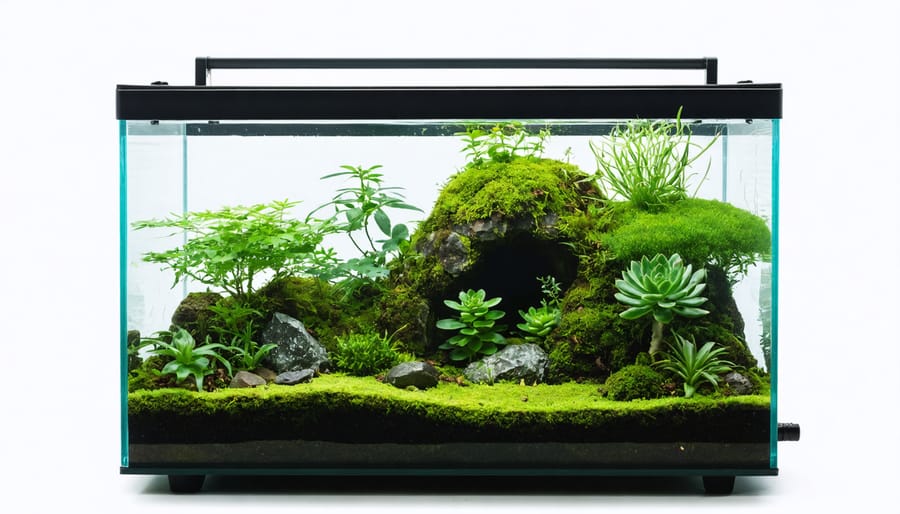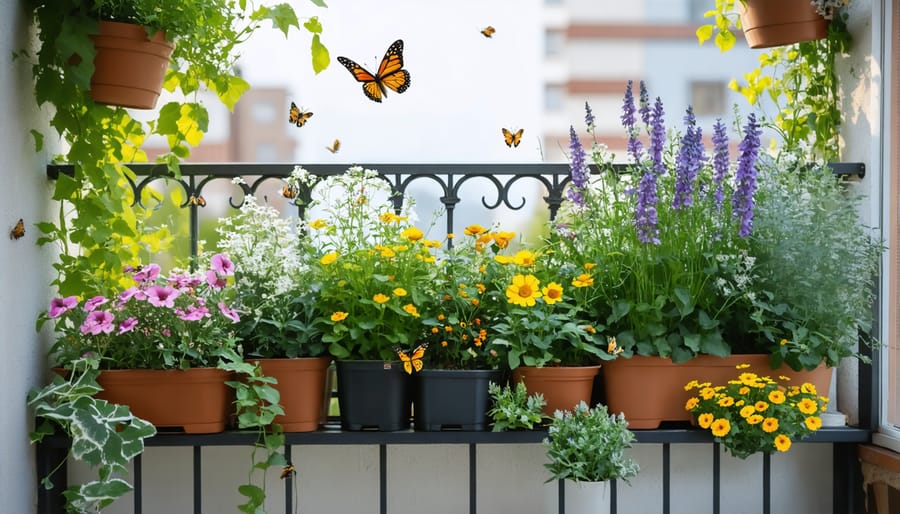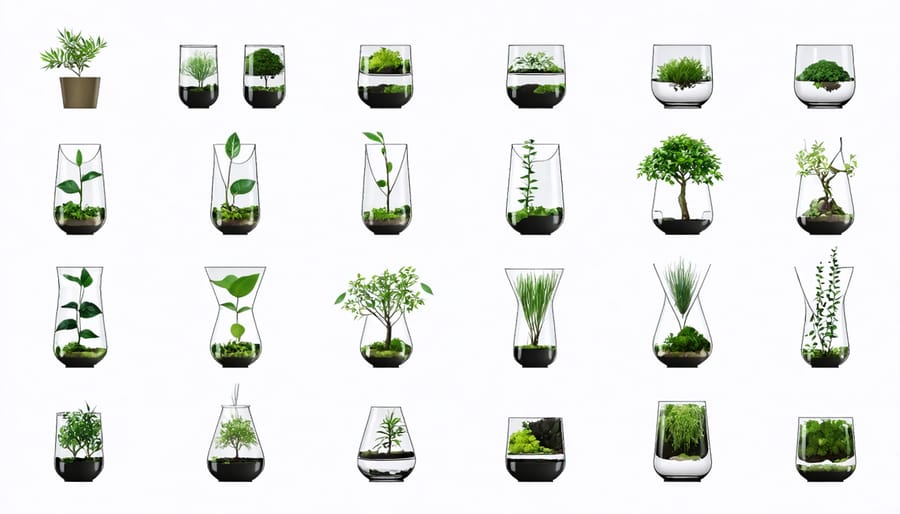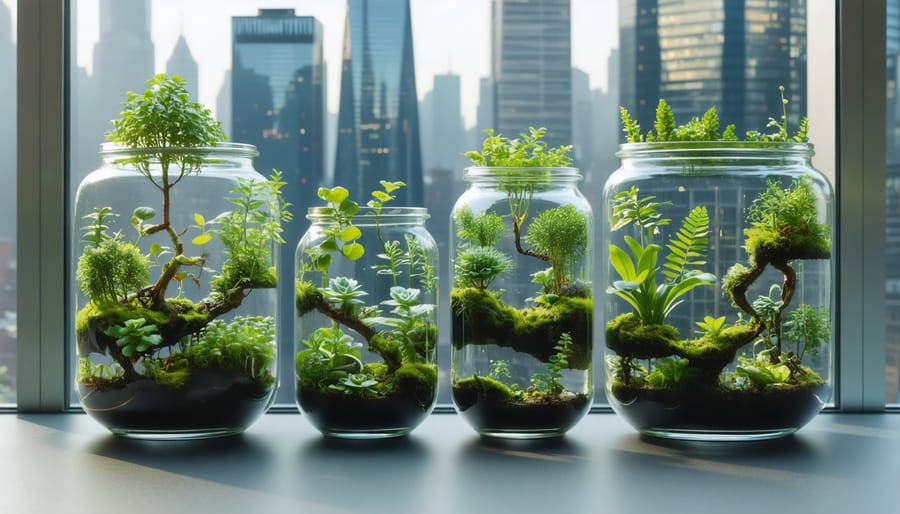Transform your windowsill, balcony, or corner shelf into a thriving miniature ecosystem where moss carpets, tiny ferns, and delicate succulents create their own self-sustaining world. These small-scale gardens pack the power of nature’s complex relationships into spaces as compact as a mason jar, teaching us valuable lessons about biodiversity and ecological balance.
In urban environments where green space comes at a premium, miniature ecosystems offer a fascinating solution for bringing nature indoors. Whether crafted in terrariums, dish gardens, or repurposed containers, these living landscapes demonstrate how plants, microorganisms, and sometimes even small insects work together in perfect harmony. They serve as both beautiful decorative elements and practical examples of sustainable ecosystems, making them ideal for homes, offices, and educational settings.
Beyond their aesthetic appeal, these pocket-sized biomes provide hands-on experience with fundamental ecological principles. By observing the water cycle, nutrient exchange, and growth patterns in a controlled environment, gardeners of all skill levels can better understand the delicate balance that exists in nature – all while creating stunning living artwork that thrives with minimal maintenance.
What Makes a Miniature Ecosystem Work?
The Living Elements
At the heart of every miniature ecosystem lies a delicate balance of living elements working together in harmony. When it comes to creating balanced ecosystems, even the smallest players have important roles to play. Plants form the foundation, converting sunlight into energy and providing food and shelter for other organisms. Choose a mix of different plant types – perhaps a small groundcover, a flowering plant, and a miniature shrub – to create diverse habitats.
Beneficial insects like ladybugs, praying mantises, and tiny pollinators naturally find their way into these spaces, helping with pest control and pollination. Don’t be surprised to spot earthworms making themselves at home; they’re excellent at aerating the soil and breaking down organic matter.
The real magic happens at the microscopic level, where billions of beneficial bacteria and fungi form complex networks in the soil. These microorganisms help break down nutrients, making them available to plants, and even communicate through underground networks. Together, these living elements create a self-sustaining system that mimics nature’s perfect balance, just on a smaller scale.
The Physical Environment
The foundation of any miniature ecosystem starts with selecting the right container. Glass terrariums are popular choices, offering excellent visibility and maintaining humidity levels effectively. However, ceramic pots, repurposed mason jars, or even old fish tanks can work wonderfully, provided they have proper drainage or a way to manage moisture levels.
Soil composition is crucial for success. A well-draining mix typically includes regular potting soil, perlite, and activated charcoal. The charcoal helps filter water and prevents bacterial growth, while perlite ensures proper aeration. For desert-themed ecosystems, add more sand and gravel, while tropical setups benefit from additional organic matter and sphagnum moss.
Water features can range from simple misting systems to small decorative ponds created with shallow dishes or natural stones. These not only add visual interest but also provide essential moisture for plants and any small creatures that might inhabit your ecosystem.
Consider adding rocks, branches, and other natural elements to create different microclimates within your container. These structural elements provide varying levels of shade, moisture retention, and growing surfaces for plants, mimicking the complexity of natural environments.
Popular Types of Urban Miniature Ecosystems
Terrariums: Self-Contained Worlds
Terrariums are fascinating miniature worlds that bring the magic of nature into your home while requiring minimal maintenance. These self-contained ecosystems come in two main varieties: closed and open systems, each with its unique characteristics and care requirements.
Closed terrariums are like tiny greenhouses, completely sealed to create their own water cycle. The moisture from the soil and plants evaporates, condenses on the glass walls, and falls back as tiny droplets, mimicking nature’s rain cycle. These systems are perfect for moisture-loving plants like ferns, moss, and tropical varieties that thrive in humid conditions.
Open terrariums, on the other hand, allow air to flow freely and are ideal for plants that prefer drier conditions, such as succulents and cacti. While they don’t create their own water cycle, they offer more flexibility in plant choice and arrangement. They also allow you to interact more directly with your plants, making them perfect for hands-on gardeners.
Both types share common elements: a clear glass container, drainage layers of gravel or activated charcoal, well-draining soil, and carefully selected plants. The key to success lies in choosing plants with similar care requirements and maintaining the right balance of moisture and light. When properly set up, these miniature gardens can thrive for years with minimal intervention, creating their own sustainable ecosystem right on your windowsill.

Balcony Butterfly Gardens
Transform your balcony into a vibrant butterfly sanctuary, no matter its size! Even the smallest outdoor space can play a vital role in supporting local biodiversity and creating a haven for pollinators.
Start by selecting containers with good drainage and filling them with nectar-rich flowers that butterflies love. Marigolds, zinnias, and lantana are excellent choices for sunny balconies, while butterfly bush and native wildflowers add vertical interest. Remember to include host plants like parsley and dill, where butterflies can lay their eggs.
Layer your plantings to create different heights and micro-climates. Place larger containers at the back and shorter ones in front, creating a natural amphitheater effect. Add a shallow water dish with pebbles where butterflies can safely land and drink.
Consider incorporating these butterfly-friendly elements:
– A mix of annual and perennial flowers for continuous blooming
– Bright colors, especially purple, yellow, and red
– Sheltered spots to protect butterflies from wind
– Native plant species that local butterfly species recognize
– A small rock or piece of driftwood for basking in the sun
Maintain your balcony garden organically, avoiding pesticides that could harm these delicate creatures. Water deeply but less frequently, and deadhead spent blooms to encourage continuous flowering. Soon you’ll have a thriving miniature ecosystem that brings joy to both you and your winged visitors.

Windowsill Water Gardens
Transforming your windowsill into a thriving aquatic ecosystem is easier than you might think. These miniature water gardens bring the tranquility of natural ponds into your home while creating a sustainable environment for aquatic plants and small creatures.
Start with a clear glass container at least 6 inches deep, ensuring it fits comfortably on your windowsill. Layer the bottom with aquarium gravel or small pebbles, which provide a foundation for root growth and beneficial bacteria. Select a variety of aquatic plants that thrive in different water depths – floating plants like duckweed, submerged plants such as hornwort, and emergent plants like miniature cattails.
The key to a successful windowsill water garden is balance. Aim for a mix of 70% plants and 30% open water. This ratio helps maintain oxygen levels and creates natural filtration. Consider adding a few small snails or shrimp, which act as natural cleaners and add movement to your ecosystem.
Place your container where it receives indirect sunlight for 4-6 hours daily. Too much direct sun can lead to algae growth, while too little light will stunt plant growth. Change about 25% of the water monthly to maintain water quality, and trim plants as needed to prevent overcrowding.
Watch as your miniature ecosystem develops its own rhythm, with plants growing, tiny organisms multiplying, and a perfect balance emerging naturally over time. It’s a fascinating way to observe nature’s cycles up close while adding a unique decorative element to your home.
Step-by-Step: Building Your First Miniature Ecosystem
Choosing Your Location and Container
The foundation of your miniature ecosystem starts with two crucial decisions: location and container choice. For location, consider a spot that receives consistent light – most plants thrive with 4-6 hours of daily sunlight. Indoor settings near windows or outdoor spaces on patios work well, but avoid areas with extreme temperature fluctuations.
When selecting your container, think about both aesthetics and functionality. Glass terrariums are popular choices as they create a greenhouse effect and allow easy viewing of your ecosystem. Traditional plant pots, repurposed mason jars, or even old fish tanks can work beautifully. Ensure your container has proper drainage unless you’re creating a closed terrarium system.
Size matters too – larger containers offer more stability and room for plant growth, while smaller ones are perfect for desktop gardens. Whatever you choose, make sure it’s clean and has enough depth for root development (at least 6 inches for most plants). If you’re placing it outdoors, select weather-resistant materials like ceramic or treated wood to ensure longevity.
Remember, your container choice will influence which plants you can grow and how much maintenance your ecosystem will need.

Plant Selection and Placement
Selecting the right plants for your miniature ecosystem is crucial for its success and sustainability. Start by choosing plants that share similar care requirements, particularly when it comes to water, light, and humidity needs. For tropical terrariums, consider combining ferns, moss, and small-leafed vines that thrive in humid environments. Desert-themed ecosystems work well with various succulents and cacti species that prefer drier conditions.
When arranging your plants, think in terms of layers. Place taller plants like small palms or snake plants toward the back or center, medium-height plants in the middle ground, and ground-covering species in the front or around edges. This creates visual interest and mimics natural plant communities.
Consider growth rates and mature sizes when selecting plants. Slow-growing varieties are often ideal for miniature ecosystems as they won’t quickly outgrow their space. Some excellent choices include peperomia, tiny ferns, and miniature African violets for tropical settings, or echeveria and haworthia for desert themes.
Remember to leave enough space between plants to allow for growth and air circulation. A good rule of thumb is to space plants at least an inch apart, depending on their mature size. This prevents overcrowding and reduces the risk of disease while creating a more balanced, natural-looking arrangement that will thrive over time.
Maintenance and Care Tips
Regular maintenance of your miniature ecosystem is crucial for its long-term success. Start by monitoring moisture levels daily – the soil should be consistently damp but never waterlogged. Use your finger to check the top inch of soil; if it feels dry, it’s time to water. A spray bottle works best for gentle watering that won’t disturb your delicate plants.
Trim dead leaves and prune overgrown plants monthly to maintain the ecosystem’s balance and prevent any single species from dominating. Watch for signs of pest infestation or fungal growth, which can spread quickly in enclosed environments. If you spot any issues, remove affected plants promptly to protect the health of your system.
Every three months, carefully remove accumulated debris and clean any glass surfaces to ensure optimal light penetration. Replace or supplement the soil annually with fresh, nutrient-rich substrate to replenish depleted nutrients. For open terrariums, rotate them quarterly to ensure even growth, as plants naturally grow toward light sources.
Remember that each ecosystem is unique – observe your plants’ behavior and adjust care routines accordingly. Less intervention is often better, as these mini-worlds are designed to be self-sustaining.
Troubleshooting Common Issues
Balance and Harmony
Creating a balanced miniature ecosystem requires careful attention to the delicate relationships between plants, soil, water, and light. Just like in nature, these small-scale environments need the right proportions of each element to thrive. When one component becomes too dominant, the entire system can be thrown off balance.
To maintain harmony, start by selecting plants with similar care requirements and growth rates. Fast-growing species can quickly overshadow slower ones, leading to competition for resources. Pay attention to moisture levels – while some plants love humidity, others prefer drier conditions. The key is finding that sweet spot where all inhabitants can flourish together.
Common issues include algae growth from excess nutrients, pest infestations due to poor air circulation, or plant decline from improper lighting. The good news is that these problems are usually easy to correct with minor adjustments. Regular observation is your best tool – spend a few minutes each week checking for signs of imbalance and address any issues promptly.
Remember that achieving perfect balance takes time and patience. Your miniature ecosystem will naturally evolve and find its equilibrium as the different elements learn to coexist harmoniously.
Plant Health Concerns
Even in carefully maintained miniature ecosystems, plants can face several common health challenges. Yellowing leaves often indicate overwatering or poor drainage, while brown leaf tips might suggest low humidity or excessive fertilizer. To address these issues, adjust your watering schedule and ensure proper drainage by adding a layer of small stones at the bottom of your container.
Root rot, a frequent concern in enclosed environments, can be prevented by avoiding water-logging and maintaining good air circulation. If you notice fuzzy growth on your plants or soil, you likely have a fungal issue. Combat this by reducing moisture levels and increasing ventilation.
Pest problems, though less common in closed systems, can still occur. Spider mites, scale insects, and fungus gnats are the usual culprits. Instead of reaching for chemical solutions, try natural pest control methods like neem oil or introducing beneficial insects.
Remember, prevention is better than cure. Regular monitoring, proper plant spacing, and maintaining appropriate humidity levels will help keep your miniature ecosystem thriving. If problems persist, don’t hesitate to remove affected plants to protect the overall health of your system.
Creating a miniature ecosystem is more than just a gardening project – it’s an opportunity to witness nature’s intricate relationships up close while contributing to environmental sustainability. From terrariums to container gardens, these small-scale habitats offer endless possibilities for creativity and learning. Whether you’re working with limited space or want to bring a piece of nature indoors, starting your own miniature ecosystem can be both rewarding and educational. Remember to start small, observe carefully, and adjust as needed. The beauty of these systems lies in their ability to evolve and adapt over time. Why not begin your journey today? With just a few basic supplies and a spirit of adventure, you can create your own thriving microcosm of life that will bring joy and wonder for years to come.




